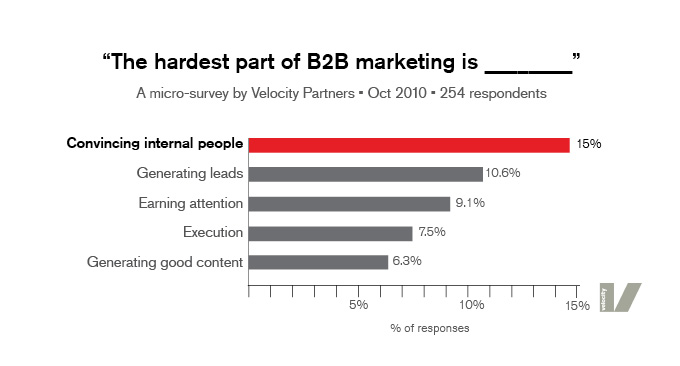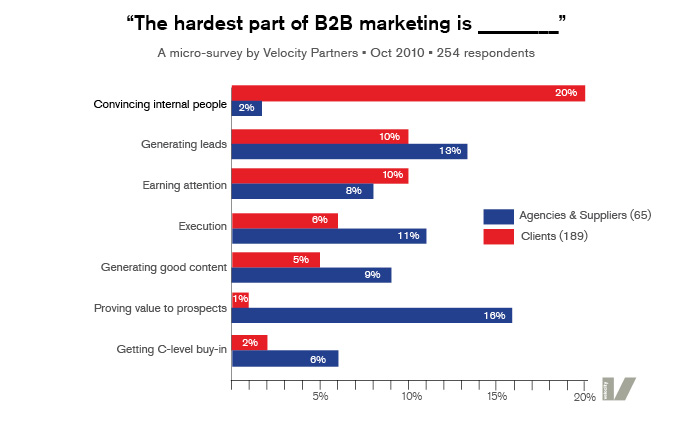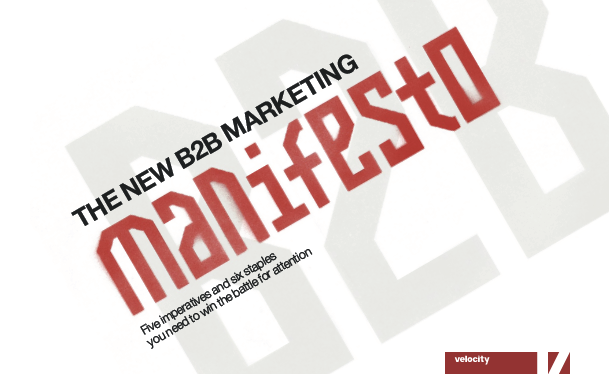As part of our B2B Marketing Manifesto campaign, we asked a single, simple question in the download form. Tucked under the boxes for name, email and company name is the optional question: “The hardest part of B2B marketing is____”.
To be honest, we threw this question in as an afterthought but it’s proven to be one of the most interesting things we’ve done in the Manifesto campaign, so we’d like to share it here in our ‘living case study’, Project Open Robe.
Let’s admit right out front that this ‘micro-survey’ isn’t particularly scientific. It’s not a random sample of B2B marketers (just the kind who download things like B2B manifestos) and the question itself is open to many different interpretations (like what do we mean by ‘hardest’ anyway?).
But the results are even better than rigorous: they’re interesting. And they really do make me think a bit differently about B2B. Because what it shows is a kind of snapshot of the state of mind of B2B marketers today. Not a detailed analysis of our priorities but a peek into how we think about our work. The fact that this was a top-of-the-head question rather than a ‘sit down and take a survey’ kind of experience might even make it more valuable as a mindset indicator. The Wordle of all the responses (above) reads like a CAT scan of any B2B marketer’s brain.
Here are the top five answers, shown as a percent of total answers (clients and agency/suppliers are all lumped together in this one):
A Bombshell: the enemy within
One rather shocking result jumped out of this little exercise: the number one obstacle B2B marketers identify has nothing to do with actually getting through to prospective buyers, winning their attention, convincing them to engage or getting them to buy. The number one obstacle isn’t about creating great content, generating high-quality leads or proving ROI (though all of these showed up in the top five).
The hardest part of B2B marketing turns out to be convincing other people within the company to do the right things. It’s worth saying it again in the boldest face WordPress will allow:
The hardest part of B2B marketing is fighting internal battles.
Think about this. Of all the incredibly challenging things we all have to struggle with, we’re most daunted by getting our bosses or boards or other departments to value us, listen to us and take our advice (these are the kinds of words people used — they’re masked by our aggregated term “Convincing internal people”).
I don’t know about you but seeing this in the cold light of Excel kind of gave me a kick in the head.
But when I thought about it a bit, it not only makes sense, it explains a lot of what I’ve experienced in my 25 years in the business. Here’s what I think this curious little crumb of data actually means:
B2B marketers are not very powerful
We’re not highly valued inside our companies
Our expertise is suspect
Why would this be so? I hate to say it but it’s probably because the doubters are absolutely right: B2B marketers have not earned the respect of our peers and our bosses because we have not delivered clear, undeniable value to our businesses.
Ouch.
Part of this may be that B2B businesses are less likely to be ‘marketing driven’ than consumer marketing companies are (I could be wrong but I’d be amazed if B2C marketers were as concerned by internal obstacles). In Nike and Coca-Cola, marketing is the most powerful department not one of the least. Rightly or wrongly, B2B companies are often more sales-driven or engineering-driven. You don’t find many consumer brands that aren’t all about the marketing.
A client-side issue
Our first reaction to the topline data was to ask, “Was the focus on internal obstacles skewed by agency-side whingers?” We thought it must be but the data says quite the opposite. Here’s how client-side marketers differ from agency/supplier side:
As you can see, the agency side didn’t really rate the internal problems highly at all. They did, however consider things like “Proving value to prospects” and “getting C-level buy-in” as the hardest part of their jobs — far higher than their client-side peers.
So it seems safe to say that many B2B marketers within companies are struggling in their efforts to be heard, valued, respected and left alone to do what they know is right for the business.
What can we do about it?
The B2B Marketing Manifesto is really all about this challenge: how marketers can thrive in The Land of Accountability” — and prove our value as we do it.
So the first action is to read the damn thing and see if it inspires a new way of thinking about your job.
Then, it feels like it’s time for some soul-searching: How much value are you really adding to your business? Can you prove it? Have you shown the evidence to the important stakeholders?
If the answer is ‘no’ to any of these questions, here’s a follow-up: Why not?
B2B marketers of the world: rise up! We have nothing to lose but the poor opinion of our peers…
What do you think? We’d love to hear your views on this.
——
Want the full Open Robe picture?
Project Open Robe Part 1 – the one where we commit ourselves in public (Planning)
Project Open Robe Part 2 – the one where it all kicks off (Thinking)
Project Open Robe Part 3 – the one where confidence starts to rise (First results)
Project Open Robe Part 4 – the one where the trick shots start (Cross-promotion)
Project Open Robe Part 5 – the one where we share the first month’s results (Reviewing)
Project Open Robe Part 6 – the one where we toughen up (Soul Searching)
Project Open Robe Part 7 – the one where we find the world’s best marketers (Segmenting)
Project Open Robe Part 8 – the one where we show that design isn’t everything (Style v Substance)
Project Open Robe Part 9 – the one where lead nurturing proves its worth (Marketo)
Project Open Robe Part 10 – the one where the form fights back (Form v No Form)
Project Open Robe Part 11 – the one about autoDMs in Twitter
Project Open Robe Part 12 – the one about re-purposing and atomising your content
Project Open Robe Part 13 – the one with an early peek at the outcomes
Project Open Robe Part 14 – the one where it ends (before it starts again)
A kind of Quasi–Methodology
The data above represents the first 254 responses to the open-ended question, “The hardest part of B2B marketing is___”. Of these, 189 were client-side and 65 were agency or supplier-side (including marketing tools vendors).
There was a wide variety of answers, which we grouped into 35 different buckets. If someone gave two or three answers, we counted them all. Someone else looking at the raw data might put a few responses into different buckets than we did, but the numbers are big enough to feel our results are worth noting.

Enjoyed this article?
Take part in the discussion









Comments
Peter Johnston October 19th, 2010
I would guess that convincing their colleagues, especially their bosses, is the hardest part of any executive’s job.
This is something forgotten by many marketers. We create nurturing programmes on the basis of convincing our recipient, totally forgetting that at some point he has to take all this stuff in front of his colleagues. What seems like a perfect nurturing campaign can often come totally off the rails at that point.
We put it down as a buyer who doesn’t know what he/she wants. But actually it is that our sell-through material wasn’t good enough.
A good salesperson often asks the question “Who else needs to be involved in this decision”. Often he/she will arrange things so he can present to the board.
But most marketers don’t even ask the “who else” question. They should be sending specifically targeted materials to upwards of half a dozen people in the same company, surveying them to find out their buying criteria and inviting them to ask questions.
Doug Kessler October 19th, 2010
You might be right, Peter. It does feel that something’s wrong if the hardest thing in B2B marketing is earning the right to market. But it’s true, we have no control group here — maybe ‘internal obstacles’ would come top in any discipline in the world.
Maybe, as you say, marketers need to market themselves and their ideas better…
Peter Tait October 19th, 2010
These results are intriguing, but not all that surprising. I think there are two clear reasons why this happens:
1) The challenge of measuring Marketing contribution. Most teams struggle with proving their contribution to the revenue number, and without a clear proof of Marketing’s value they will continue to be the CFO’s go-to target when budgets need cutting. Even within the team, the lack of a clear way to measure the effectiveness of one campaign versus another makes for guaranteed subjectivity and infighting.
2) Lack of communication with Sales. If the Sales teams don’t know what’s coming, they won’t do justice to Marketing leads. Poor lead follow-up leads to less bottom-line impact, and the impression that Marketing spends a ton of money without any commitment to generate revenue.
Neil Stoneman October 19th, 2010
Hi Peter,
Do you think there’s a lack of a way or a will to measure a marketing campaign’s effectiveness? While nothing’s totally foolproof it feels to me like a lot of B2B teams are overlooking, or undervaluing, the growing number of measurement options out there.
Feels like the opportunity for us marketers to fight back on this front is there if we want to take it.
Rob Catalano October 19th, 2010
I find it pretty interesting that the ‘Execution’ answer is also in the top 5 – something that in my mind can be added to the #1 answer of convincing internal people. the way i look at it, internal stakeholders are usually the barrier to have execution happen, or happen well w/ permitting investment in the right tools or people.
I equate it to the HR world of a study I did with HR executives and the importance of rewards and recognition and what their biggest pain is… and it was ‘getting executive buy-in’. Another internal barrier towards something that has proven to work and a community believes in….
great study btw… keep this stuff up!
Doug Kessler October 19th, 2010
Thanks Rob. There were a few other answers that also could be added to ‘Convincing internal people’ (like ‘aligning sales & marketing teams’. So the internal buy-in side of things is even more dominant.
Maybe Peter Johnston’s comment above is right: buy-in is the main obstacle to every exec in every discipline.
But I do think it speaks specifically to B2B marketers as well…
Philipos Sfiris October 19th, 2010
From the client side, I think that the big challenges regarding internal battles are:
(a) Traditional attitudes towards marketing
Most B2B SMEs still see it not as a strategic capability but as a tactical, supporting function to sales. As more products and markets become commoditized, I think this will change. Because companies will have to develop new strategies (based on segmentation, targeting, positioning) in order to differentiate and communicate clearly their added-value.
(b) Difficulty to prove contribution to revenue
In my company, this is very diffucult, because of the complexity of the sales cycle: sometimes we cannot tell if a lead comes from marketing or sales. Online metrics are not enough. A closed-loop lead management process is needed, where sales and marketing monitor the sales and buying process and act accordingly. Lead nurturing is a great concept that can help us with this.
(c) Lack of political power
It is true that most B2B companies are sales-oriented. But that is mainly because (i) they see the customer and (ii) they own the numbers (pricing, budgets, etc).
Do you think that a temporary transfer (6-12 months) to the sales team would help?
Doug Kessler October 20th, 2010
Love the idea of putting marketing people on secondment to the sales department, Philipos.
And I agree with your points. It is hard to prove contribution to revenue but we’ve got to lobby for the closed loop you refer to.
In our experience, the very best B2B marketers are the ones who own the sales pipeline.
Mark McClure October 24th, 2010
Oh dear. Not much has changed since the late 80s has it? When, as a tech trainer, I’d see and hear Sales give marketing a good thumping before, during and after kick offs and product launches.
Maybe marketing needs to add some more analytical firepower. Is there a role for the “marketing quant”?
Susan Fantle October 26th, 2010
Doug,
It was interesting to get my Tuesday Marketing Notes email today and find your post echoing an issue I recently addressed in my blog. I called it “Today’s 3 Biggest B2B Marketing Success Barriers are Human.” I identified these barriers as the CEO, the product manager and the sales manager. The approach that must be taken to overcome these barriers is marketing. That is we must sell the marketing strategy to them the same way we market to prospects. It’s time-consuming and painful to do but I think it’s better than doing marketing poorly because we don’t have the will to fight back.
I see this in many of my clients. By keeping the internal people happy they compromise the quality of the marketing.
Doug Kessler October 31st, 2010
@ Mark — All marketers need to be quants now. Well put.
@ Susan – I totally agree: it’s time marketers marketed themselves to your three barriers, turning them into allies.